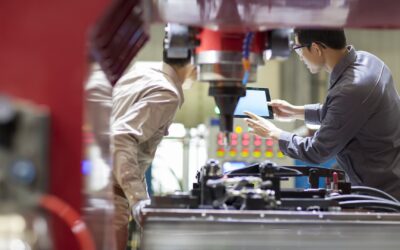The digital technologies of Industry 4.0 have given American manufacturing a golden opportunity to level the playing field and re-shore much of the production that went to areas of the world where low-cost labor was available. At Automation Alley, we believe manufacturers that embrace new software, additive manufacturing, distributed manufacturing and other Industry 4.0 concepts will have a better chance at rising above the competition.
Unfortunately, more than a decade after the term Industry 4.0 was born, far too many manufacturers are still reluctant to embrace the digital transformation of manufacturing. The excuses are as easy as they are plentiful:
We’ve all heard these excuses, and while it can be challenging to make the transition to Industry 4.0, companies that don’t do anything are at risk of being left behind by their competitors. To keep up, companies must prioritize digital transformation, explore 3D printing and be willing to embrace a software-driven business model. It’s important to explore three key Industry 4.0 components and illustrate how they can benefit a manufacturer.
Emerging technology continues to transform the world of global advanced manufacturing by creating competitive advantages and unlocking new value for companies that adopt them. Software transformation, additive manufacturing and distributed manufacturing are three major emerging trends that are becoming critical to how manufacturers operate in the world of Industry 4.0.
Software (or digital) transformation for Industry 4.0
At the heart of the Industry 4.0 is transitioning to a software-first mindset, which means replacing standard (or non-digital) manufacturing processes and operations with digital solutions to enhance how a business operates. No matter the industry, this transition is one of the critical components to staying competitive in today’s market.
With a software-first business model, manufacturers have the opportunity to gain infinite flexibility to pivot during technological disruptions, such as artificial intelligence and shifting customer demands.
For example, Air & Liquid Systems in Rochester, Michigan, is using a 3D printer to print a part that used to cost $100 and was made of stainless steel. Because the company implemented this software-first business model into its daily operations, cost to make the needed carbon-fiber part is only $1. The integration of this new technology has created a culture change and given Air & Liquid Systems a competitive advantage.
Additive manufacturing for Industry 4.0
3D printers can be used to make parts that range in size from tools for manufacturing processes all the way up to rockets that can be launched into space.
Additive manufacturing allows manufacturers to produce low volumes of products at a fraction of the cost it would take using a traditional manufacturing process. 3D printers also provide manufacturers with far greater production flexibility because the printers can produce products in any shape, size and form and can be easily changed by reprogramming the software.
Another advantage of 3D printing is it doesn’t require manufacturers to reconfigure an entire production line or existing equipment. 3D printing provides more flexibility because it is based on digital programming and can be used to augment the products the company makes or can be used to make tools that support the manufacturing process.
One of the most compelling demonstrations of the nearly unlimited potential of additive manufacturing is Relativity Space, which is creating structurally viable rockets using 3D printers. Relativity Space created and launched the first nearly entirely 3D-printed rocket in March. The rocket performed well initially, surviving Max-Q (the part of flight during which the structure of the rocket exposed to the highest amount of pressure), but failed to reach orbit. This link provide a video of the Relativity Space 3D-printed rocket launch. Despite that structural failure, Relativity Space has announced it is reconfiguring its software and is in the process of building a larger rocket, the Terran R. Additive manufacturing is so compelling, because:
Distributed manufacturing for Industry 4.0
Distributed manufacturing is a concept in which manufacturing facilities form a network to organize production spread across numerous locations.
Distributed manufacturing provides an opportunity for small manufacturers to work together to make products in a volume or scale that would have been impossible in the past. Distributed manufacturing provides networks of smaller businesses an opportunity to compete with much larger corporations.
The full benefits of distributed manufacturing, technologies, policies and other infrastructure should be aimed at incorporating democratization into distributed manufacturing.
From a technological standpoint, the building blocks for democratized models of distributed manufacturing already exist in Industry 4.0, but these technologies must continue to be harnessed to create frameworks that enable the expansion of distributed manufacturing.
For example, the Automation Alley Project DIAMOnD initiative leverages software, additive manufacturing, and distributed manufacturing technologies to create an advantage for 300 Michigan-based small and medium-sized manufacturers provided with a 3D printer. This initiative demonstrated the value of distributed manufacturing by using the printers to supply 8,000 tourniquet parts to those in need of medical assistance during the Russian assault on Ukraine.
Takeaway advice for implementing Industry 4.0 technologies
Industry 4.0 technologies are not only digital tools that get added to the line as we know it. Industry 4.0 technologies are fundamentally changing the production line, every day. Many industry leaders are aware of Industry 4.0 and the benefits of this digital transformation. They are no longer intimidated by technology and are becoming more comfortable experimenting with 3D printing, collaborative robotics, artificial intelligence and other digital tools.
Industry 4.0 is advancing at an exponential rate. If companies are to keep up (especially small- and medium-sized manufacturers), they must analyze the three key trends (digital transformation, additive manufacturing and distributed manufacturing) and begin to put them into practice. Doing so will enable flexibility, resiliency and sustainability while empowering companies and people to achieve success in the digital world.
Read the original article here.




